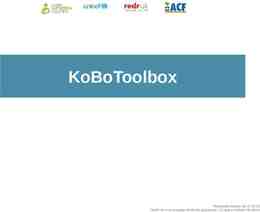John Lenhart Big data: Issues, challenges, tools and Good practices
17 Slides198.85 KB
John Lenhart Big data: Issues, challenges, tools and Good practices
Motivation Data stores are growing by 50% each year, and that rate of increase is accelerating[1] In 2010, we crossed the barrier of the zettabyte (ZB) across all online data. This year, we will produce 4 ZB of data worldwide[1] The type of data is also changing. Over 80% of it will be unstructured data which does not work well with relational databases[1]
Big Data Defined “Big data is defined as large amount of data which requires new technologies and architectures so that it becomes possible to extract value from it ” Big data is sort of a misnomer, as it only points out the size of the data not giving too much of attention to its other existing properties
Big Data’s Properties Variety - the stored data is not all of the same type or category Structured data - data that is organized in a structure so that it is identifiable e.g. SQL data Semi-structured data - a form of structured data that has a self-describing structure yet does not conform with the formal structure of a relational database e.g. XML Unstructured data - data with no identifiable structure e.g. image
Big Data’s Properties Volume - The “Big” in Big data and represents the large volume or size of the data At present the data existing is in petabytes and is supposed to increase to zettabytes in the near future For example big social networking sites are producing data in order of terabytes everyday and this amount of data is difficult to handle using traditional systems
Big Data’s Properties Velocity - represents not only the speed at which the data is incoming, but also the speed at which the data is outgoing Traditional systems are not capable of performing analytics on data that is constantly in motion Variability - represents the inconsistency of the data flow The flow of data can be highly inconsistent, leading to periodic peaks and lows Daily, seasonal and event-triggered peak data loads can be challenging to manage, especially for unstructured data[2] For example a large natural disaster would spike page visits for cnn.com
Big Data’s Properties Complexity Represents the difficulty of linking, matching, cleansing, and transforming data from multiple sources Value Systems must not only be designed to handle Big data efficiently and effectively, but also be able to filter the most important data from all of the data collected This filtered data is what helps add value to a business
Big Data in The Real World Log Storage in IT Industries IT industries store large amounts of data as logs to deal with problems which occur rarely in order to solve them Big data analytics is used on the data to pinpoint the point of failures Traditional Systems are not able to handle these logs because of their volume, raw and semi structured nature, and high rate of change Sensor Data Massive amount of sensor data is also a big challenge for Big data Example The Large Hadron Collider (LHC) is the world’s largest and highestenergy particle accelerator. The data flow in its experiments consists of 25 to 200 petabytes of data which needs to be processed and stored
Big Data in The Real World Risk Analysis It’s important for financial institutions to model data in order to calculate the risk so that it falls under their acceptable thresholds A lot of potential data is underutilized because of its volume and should be integrated within the model to determine the risk patterns more accurately Social Media The largest use of Big data is for social media and customer sentiments Keeping an eye on what the customers are saying about their products helps business organizations to get a kind of customer feedback The customer feedback can then be used to make decisions and add value to the business
Big Data Challenges and Issues Privacy and Security The most important issue with Big data which includes conceptual, technical as well as legal significance The personal information of a person when combined with external large data sets leads to the inference of new private facts about that person Big data used by law enforcement will increase the chances of certain tagged people to suffer from adverse consequences without the ability to fight back or even having knowledge that they are being discriminated against
Big Data Challenges and Issues Data Access and Sharing of Information If data is to be used to make accurate decisions in time it becomes necessary that it should be available in accurate, complete and timely manner Storage and Processing Issues Many companies are struggling to store the large amount of data they are producing Outsourcing storage to the cloud may seem like an option but long upload times and constant updates to the data preclude this option Processing a large amount of data also takes a lot of time
Tools and Techniques available Hadoop - is an open source project hosted by Apache Software Foundation for managing Big data Hadoop consists of two main components The Hadoop File System (HDFS) which is a distributed file-system that stores the data on multiple separate servers (each of which having its own processor(s)) MapReduce the framework that understands and assigns work to the nodes in a cluster[3]
Tools and Techniques available Hadoop provides the following advantages[3] Data read/write performance is increased by distributing the data across the cluster allowing each processor to do work in a parallel fashion It’s scalable, new nodes can be added as needed without making changes to the existing system It’s cost effective because it brings parallel computing to commodity servers It’s flexible, it can absorb any type of data, structured or not from any number of sources It’s fault tolerant, it handles failures intrinsically by always storing multiple copies of the data and automatically loading a copy when a fault is detected
Tools and Techniques available How do you use Hadoop? The developer writes a program that conforms to the MapReduce programming model The developer specifies the format of the data to be processed in their program How does MapReduce work?[4] Each Hadoop program performs two tasks: Map - Breaks all of the data down into key/value pairs Reduce - Takes the output from the map step as input and combines those data key/value pairs into a smaller set of key/value pairs
Tools and Techniques available MapReduce example[4]: Assume you have five files, and each file contains two columns that represent a city and the corresponding temperature recorded in that city for the various measurement days Toronto, 20 , New York, 22, Rome, 32 , Toronto, 4, Rome, 33 ,New York, 18 We want to find the maximum temperature for each city across all of the data files Then we create five map tasks, where each mapper works on one of the five files and the mapper task goes through the data and returns the maximum temperature for each city Which results in: (Toronto, 20) (New York, 22) (Rome, 33) Let’s assume the other four mapper tasks (working on the other four files not shown here) produced the following intermediate results: (Toronto, 18) (New York, 32) (Rome, 37)(Toronto, 32) (New York, 33) (Rome, 38)(Toronto, 22) (New York, 20) (Rome, 31)(Toronto, 31) (New York, 19) (Rome, 30) All five of these output streams would be fed into the reduce tasks, which combines the input results and outputs a single value for each city, producing a final result set as follows: (Toronto, 32) (New York, 33) (Rome, 38)
Questions?
References Big data: Issues, challenges, tools and Good practices http://ieeexplore.ieee.org.ezp.scranton.edu/xpls/icp.jsp?arnum ber 6612229&tag 1#references Why Every Database Must Be Broken Soon 1. https://blogs.vmware.com/vfabric/2013/03/why-every-database -must-be-broken-soon.html Big Data: What it is and why it matters 2. http://www.sas.com/en us/insights/big-data/what-is-big-data.ht ml What is Hadoop? 3. http://www-01.ibm.com/software/data/infosphere/hadoop/ What 4. is MapReduce?






















